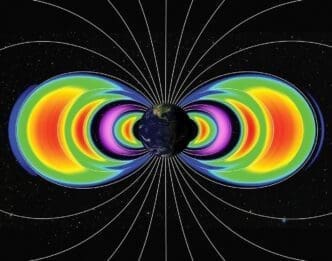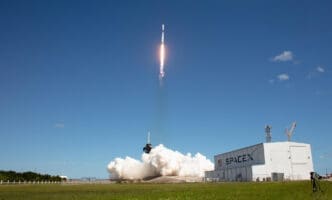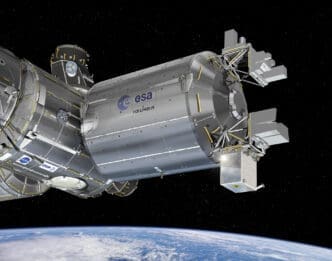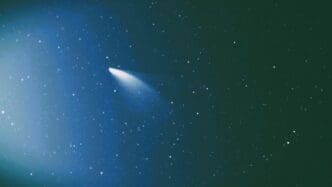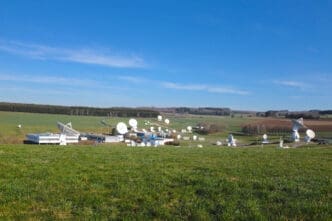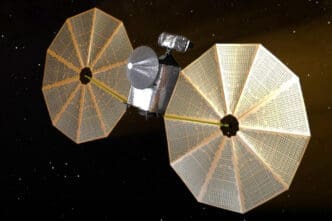In May 2024, a massive solar storm erupted, creating two new radiation belts near Earth. This extraordinary event was captured by NASA’s CubeSat, a tiny but mighty satellite. The discovery has intrigued scientists worldwide.
NASA’s CubeSat made headlines with its discovery of unexpected radiation belts. These findings have significant implications for understanding space weather and protecting technology in space. The high-energy particles can affect satellites and communication systems significantly.
The Solar Storm That Changed Everything
May 2024 witnessed the largest solar storm in two decades, sending shockwaves through Earth’s atmosphere. High-energy particles surged, lighting up skies with stunning auroras and causing disturbances in GPS systems. But beyond these visual spectacles, something remarkable was unfolding in space.
Two new radiation belts formed, positioning themselves between Earth’s well-known Van Allen Belts. These temporary belts, composed of high-energy protons and electrons, were particularly unique in their structure and longevity. Such emergent belts are rare, especially lasting ones.
Unraveling the Mystery of the New Belts
Historically, temporary belts emerged after large solar storms, primarily made of electrons. However, this time, the presence of protons alongside electrons is unprecedented. The solar storm’s intensity likely contributed to this rare phenomenon.
Professor Xinlin Li, a leading expert, remarked, “This is something really new.” The new belts lasted longer than usual, with one persisting for over three months. Solar storms’ impact is pivotal in determining their duration, influencing both spacecraft safety and scientific research.
CubeSat: The Little Satellite That Could
CIRBE, NASA’s CubeSat, made this groundbreaking discovery. This tiny space traveler is about shoebox-sized. Circling Earth’s magnetic poles, CIRBE captured invaluable data, offering insights unseen by larger spacecraft.
The CubeSat had encountered technical issues and went dark for a while. However, it miraculously came back to life, continuing its mission. This fortuitous event allowed scientists to gather data crucial to understanding these new belts.
The information gathered by CIRBE was comprehensive, offering high-resolution details that other instruments missed. Post-discovery, it was unfortunately deorbited, but its contributions remain invaluable. “We are very proud,” expressed its creators.
Impact on Space Travel
Such radiation belts are not just a scientific curiosity. They pose real threats to spacecraft, especially those venturing into geostationary orbits. These belts can damage satellites and increase risks for astronauts passing through them.
Understanding these belts is crucial for designing protective measures for future space missions. This newfound knowledge is a step toward safer space exploration, emphasizing both the challenges and opportunities in confronting space’s volatile nature.
Space missions depend heavily on accurate data about these high-energy environments. The CubeSat’s findings will aid in the development of new technologies and strategies to shield against potential space hazards.
Implications for Future Research
The appearance of proton-rich belts opens avenues for future research. Understanding the dynamics of these belts can lead to advancements in space weather prediction and mitigation strategies.
Researchers are keen to dive deeper into the forces shaping such belts. As solar activity increases with the solar cycle’s progression, future storms might offer further insights.
Continuous monitoring and studying of these transient belts can provide vital information. This ongoing research is crucial for safeguarding both current and future space assets from unpredictable cosmic events.
Reflecting on Technological Triumphs
NASA’s CubeSat project underscores the potential of small, agile satellites in space exploration. These miniature marvels prove that size doesn’t hinder capability, as they bring back data vital for scientific advancement.
The success of CubeSat invigorates the scientific community’s interest in developing more compact and efficient space technology. This project exemplifies innovation in space research, blending creativity with technical precision.
The impact of these discoveries will likely fuel future missions harnessing similar technology, pushing the boundaries of what’s possible with micro-satellites. Innovation in this sector is bound to redefine our approach to space exploration.
The Bigger Picture
Exploring these new belts contributes to our broader understanding of space weather’s influence on Earth and its surroundings. In the grand scheme, each discovery adds a piece to the cosmic puzzle.
Space weather affects not only our atmosphere but also technology and infrastructure. This discovery underscores the interconnectedness of cosmic events and our technological lives, prompting further reflection.
Future endeavors in space exploration will undoubtedly rely on this growing body of knowledge. The more we understand about space weather, the better equipped we are to tackle its challenges.
A Call to Action in Space Science
The discovery of unexpected radiation belts is a reminder of the ever-evolving nature of space. This field calls for ongoing curiosity, research, and innovation to keep pace with new developments.
Collaboration among scientists, engineers, and agencies is crucial for navigating space’s unpredictable terrain. Sharing knowledge and resources will propel advancements in space science and technology.
As the solar cycle continues, we anticipate fresh revelations. Each discovery fuels humanity’s quest for knowledge, urging us to explore the unknown and adapt our technologies accordingly.
The tiny CubeSat’s remarkable findings emphasize the importance of continued space exploration. With each discovery, we uncover new layers of space’s complexity.

